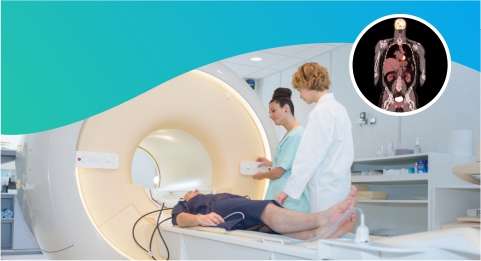
The PET CT scan stands for Positron Emission Tomography which is used to detect early signs of cancer, heart diseases as well as rule out any possibility of brain disorders.
The PET CT scan stands for Positron Emission Tomography which is used to detect early signs of cancer, heart diseases as well as rule out any possibility of brain disorders. It is an injectable radioactive tracer which uses advanced technology in order to identify the root cause of the disease cells and is also a combination of PET-CT scan producing 3D images of a more accurate diagnosis.
The PET CT scan is preferred by healthcare providers to check for signs of:
- Cancer, including breast cancer, lung cancer as well as thyroid cancer.
- Coronary artery disease, heart attack, as well as other heart problems.
- Brain disorders like brain tumours, epilepsy, dementia and alzheimer’s diseases.
A PET CT scan not only shows or measures vital functions like blood flow, oxygen use as well as blood sugar (glucose) metabolism, diagnostic centre but also identifies the organs and tissues with impaired functioning. It further is known to detect cancerous tumour cells to help gauge cancer spread metastasis.
Evaluate how well a treatment plan is working and helps the healthcare provider to make necessary changes in the treatment as and when required.
What are the types of healthcare conditions diagnosed using PET CT scans?
The solid tumours which can be diagnosed using PET CT scan vary and can be listed as follows:
- Brain
- Breast
- Cervical
- Colorectal
- Esophageal
- Head and neck
- Lung
- Lymphatic system
- Pancreatic
- Prostate
- Skin
- Thyroid
What is the Procedure for PET CT scan?
The doctors get to perform the nuclear medicine exams on the outpatients and hospitalized patients who are made to lie down on the exam table. If it is considered necessary, the nurse or the technologist will insert an intravenous (IV) catheter into the vein of your arm or hand. PET scans only use radiotracer injections.
It takes about 30-0 minutes to travel through the body and get absorbed in the area under the examination. One will be asked to rest and avoid any kind of talking and movement. It is also advised to drink some contrast material which localizes in the intestines and helps in the radiologist interpreting the examination.
One will be moved into the PET/CT scanner in order to begin imaging. One will need to remain still during the imaging. The CT exam takes place first, followed by the PET scan. On one occasion, a second CT scan with intravenous contrast will follow the PET scan.
The CT scan takes less than two minutes while the PET scan takes 20-30 minutes.
Total scanning time is usually about 30 minutes and depends on which area is under examination, with additional tests involving other tracers or drugs which may be used. For example – if one is examined for heart disease, one may undergo a PET scan both before and after exercising or before and after receiving IV medication which increases blood flow to the heart.
If you have an intravenous line for the procedure, your technologist will usually remove it and the technologist will leave it in place if you are to have another procedure the same day.
Risks involved in PET CT Scan?
The PET CT scan is a safe test for most of the people. Unlike all medical tests, it has some risks. It is the duty of the doctor to ensure the benefits of PET CT scan outweighs the risks involved.
Pregnancy
Pregnant women should only have the scan in an emergency scenario. There is a risk that the radiation could harm the developing baby. Contact the department beforehand in case you are pregnant.
Breast feeding
If you are breastfeeding, let the department know a few days before the appointment. They will surely let you know if you need to stop breastfeeding for the length of time after having the radioactive drug. One might need to store enough expressed milk for at least one feed.
Radiation
There is a high chance of exposure to radiation during the PET CT scan which can slightly increase one’s risk of developing cancer in the time to come. Since it is important to talk to your doctor if this concern worries you, one is advised to keep in close contact with the doctor.
Bruising and Swelling
One might get a smaller bruise around the area where they put the needle in. There is however a risk that the radioactive tracer will leak outside the vein. It can cause swelling and pain in the arm although it is a rare phenomenon.
Allergic reaction
Rarely, people have an allergic reaction to the radioactive tracer which most often starts with weakness, sweating and difficulty in breathing. Once you tell your radiographer immediately in case you are feeling unwell.
How does one prepare for PET CT Scan?
For most cases of PET CT scans, one needs to stop eating about 4 to 6 hours beforehand. One can usually drink water during this time, and one might have instructions not to do any strenuous exercise for 24 hours before the scans.
In case you are diabetic and cannot skip your meals, you might need to adapt your diet and sugar control and then your appointment time would be changed accordingly.
Some people feel claustrophobic when they are having a scan in which case you can contact the department staff. They can take extra care to make sure one is comfortable and that one understands what is going on.
The doctor can arrange to give you medicine in order to help you relax.









